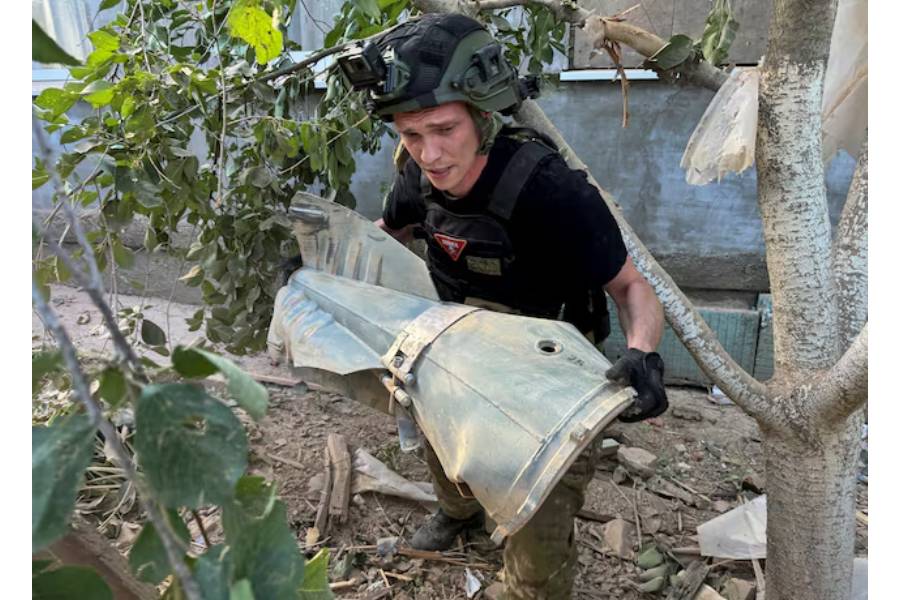
Published :
Updated :

Russia plans to manufacture up to 120,000 of its cheap and devastating glide bombs this year, a senior Ukrainian intelligence official said, including 500 of a new, longer-range version which can reach more towns and cities.
Russia has ramped up arms production massively since the full-scale invasion of Ukraine in 2022, with defence plants operating around the clock. It does not disclose details of military output, which are classified as secret.
Reuters was unable to verify the 2025 target, which Major General Vadym Skibitskyi, deputy head of Ukraine’s Defence Intelligence disclosed in an interview.
He did not say how he had obtained the figure or give earlier data, but it would indicate a vast increase in the manufacture of glide bombs, which use wings, and sometimes engines, to fly dozens of kilometres to their targets.
The 120,000 number includes new munitions and existing bombs upgraded to glide.
Skibitskyi said Russian forces are firing between 200 and 250 glide bombs every day. Last month, the daily average was about 170, according to data from the defence ministry.
“It is possible to shoot them down, but the quantity of these aerial bombs produced in the Russian Federation ... is enormous,” Skibitskyi said. “This is a threat. A threat that will require us to respond appropriately.”
RUSSIA IS BOOSTING GLIDE BOMB RANGE
The bombs, whose range was previously estimated to be up to 90 km (56 miles), can breach Ukrainian defences without sending planes across front lines where they would be shot down.
They are much cheaper and more plentiful than missiles and their several hundred kilograms of explosive can blast through buildings and fortifications. They have pummelled frontline cities such as Kharkiv and Kherson.
Russia is launching mass production of a new glide bomb capable of flying up to 200 km (125 miles) from the point of release from a fighter jet, Skibitskyi said, adding that it plans to make about 500 by the end of this year.
Ukraine also believes that Russia is working on modifications so such bombs can fly up to 400 km, allowing Moscow to target even more Ukrainian towns and cities without using missiles, he said.
October glide bomb attacks on Mykolaiv, Poltava and Odesa regions, which are at least dozens of kilometres from the nearest front lines, have already demonstrated the increasing reach of the weapon.
The Russian defence ministry did not immediately respond to a request for comment. Russia denies targeting civilians, but thousands have been killed and injured in the invasion. Moscow argues that Kyiv’s moves to ally with the West pose a threat to Russia and must be stopped.
INTENSIFYING ATTACKS AIMED AT FORCING KYIV’S HAND IN TALKS
Skibitskyi also gave estimates for Russian drone production, which he said had enabled it to target Ukraine’s energy system more effectively.
In 2025 Russia would make a total of about 70,000 long-range drones, he said, including 30,000 Shahed craft which are the workhorse of Russia’s attacks.
“They started with 30 drones per month, now 30 can fly to a single target,” he said, expecting the attacks on gas and energy infrastructure to continue into the winter.
“They definitely want to break us. This is destabilising the internal situation,” he said. Skibitskyi described it as one of the tools to pressure Ukraine into a more compliant position in any possible peace negotiations.
He also said that should Russian troops capture the besieged city of Pokrovsk, where street battles are currently raging, they would likely press towards the boundaries of Donetsk region, their long-held goal.
“It’s their next direction of movement, it’s obvious.”
NORTH KOREA MAKING ITS OWN DRONES
The shipment of millions of rounds of artillery shells from North Korea helped Russia keep up rates of fire on the battlefield in 2024, but Skibitskyi said the number had more than halved this year as Pyongyang’s stocks ran low.
He cited a total supply of 6.5 million artillery shells to Russia since 2023 from North Korea, which seized on an opportunity to build close ties with the Kremlin after Russia’s invasion of Ukraine.
He said there were no shell deliveries recorded from North Korea in September, but some were recorded in October and that about half the shells supplied by Pyongyang were so old that they needed to go to plants in Russia to be improved.
Skibitskyi added that North Korea had launched mass production of small, short-range First Person View (FPV), as well as larger medium-range battlefield attack drones, on its own soil, although he did not specify the scale.
“They are learning, they are studying their experience (in this war) in order to expand production in their own territory,” he said.
Thousands of North Korean troops fought last year alongside Russian forces in Russia’s Kursk region after an incursion by Ukraine to try to ease pressure on its forces elsewhere and create leverage in peace talks.
North Korea has acknowledged its involvement in Ukraine, arguing that its role helps to preserve world peace in the face of aggression by the West but it has not given any details or responded to requests for comment on its involvement.


 For all latest news, follow The Financial Express Google News channel.
For all latest news, follow The Financial Express Google News channel.